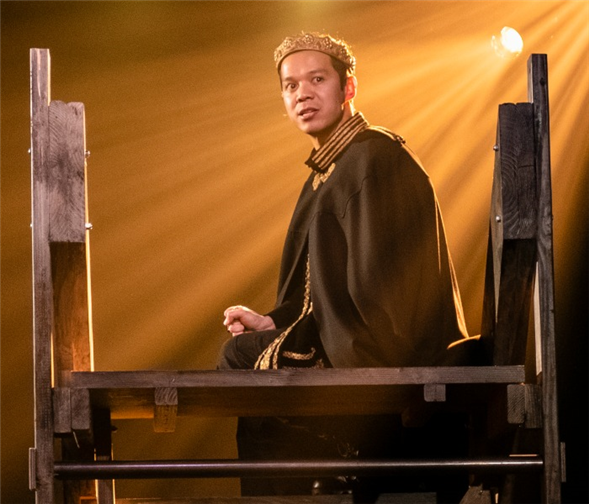Translate Page

Why NAATCO is mounting Shakespeare's rarely done epic
---
Mia Katigbak has wanted to stage Shakespeare's three-part history saga Henry VI ever since she saw a production at the Public Theater two decades ago. For years, the co-founder and artistic director of the National Asian American Theater Company (NAATCO) pitched the epic as a potential project to various directors, but "every time I brought it up, they looked at me as though I was totally nuts!" she says. Then she suggested it to Stephen Brown-Fried, who helmed NAATCO's acclaimed revival of Clifford Odets' Awake and Sing!. "I saw his eyes light up and I thought, oh, he's as crazy as I am," Katigbak says, laughing.
Organized into a two-show, six-hour theatrical event, NAATCO's Henry VI at A.R.T./New York Theatres is quite the ambitious undertaking. "Part 1: Foreign Wars" kicks off with the funeral of King Henry V, then zips back and forth between bloody battlefields in France, where the British occupying forces are being attacked by Joan of Arc, and the chaotic English court, where rival lords are vying for control of the new underage king and his country. "Part 2: Civil Strife" charts a nation spinning out of control as the houses of Lancaster and York, both laying claim to the English throne, wage the grueling wars of the Roses, paving the way for the ascent of Richard III.
"The Henry VI plays are very rarely done and certainly present all sorts of challenges," says Brown-Fried, who notes that other authors are believed to have collaborated on this early Shakespeare opus. "If we did them uncut, the production would be twice as long! What's exciting to me is that you feel the maturation of writing style going on through the plays. In the last part, you begin to catch glimpses of who Shakespeare would become."
Another exciting aspect of NAATCO's mounting: its all-Asian-American cast, some of whom have never had the chance to tackle the Bard before. Brown-Fried recalls a moment in rehearsals when Ron Domingo, who's been acting professionally for 20 years, was struggling with a particularly tough speech as the blind earl Mortimer. "He turned to me and said, 'You know, I spent a lot of my career resenting Shakespeare because the doors were always closed to me. What a different actor I would be today if I'd had the opportunity to work more on this kind of language,'" remembers Brown-Fried. "That was heartbreaking for me. The encouraging coda to that story is that there are other members of this company -- particularly some of the younger ones like Kim Wong, who plays Joan of Arc, and David Huynh, who plays Richard III -- who have spent massive portions of their careers doing Shakespeare."
Born in the Philippines, Katigbak is a veteran performer who's been working for decades to expand the opportunities available to Asian-American theatre actors. While their representation on New York stages still lags behind other minority groups, she acknowledges it's better than it was when NAATCO started in 1991. "The Asian-American actor scene has changed quite significantly and dramatically since then," she says. "There are so many more Asian-American actors coming out of conservatory programs with the training -- they are the third generation. In my generation, our parents were worried that you couldn't make a living as an actor and that you had to be a doctor or an accountant."
One of Brown-Fried's first Henry VI decisions was to cast Katigbak as the Duke of Gloucester, the young king's uncle and Lord Protector of England. "Gloucester certainly has his flaws but is basically a well-intentioned political leader -- and he is just circled by this kind of web of barracudas who take him down," the director explains. "I was working on the play during the whole of the 2016 election and I couldn't stop seeing the resonances between Hillary and Gloucester, this idea of a public leader who really was never going to be able to overcome the quantity of hatred that was surrounding her."
Katigbak says they initially considered changing pronouns to reflect the fact that she is playing Gloucester, but they ultimately left the text unchanged. "The fascinating thing is just by casting a woman in the part, all the conversation that surrounds all these issues today is suddenly there without us having to contort ourselves," she says.
The director agrees that Henry VI feels frighteningly relevant, even more than it did when they decided to do it two years ago. "There are scenes where Shakespeare shows the incredibly misled violence that can occur when people who feel underserved by their country rise up but aren't entirely sure what their best interests are," says Brown-Fried. "Henry VI is an exploration of what can happen to a nation -- and the worst things that humanity is capable of -- in the absence of effective leadership."
---
TDF MEMBERS: At press time, discount tickets were available for Henry VI Part 2: Civil Strife. Go here to browse our current offers.
Gerard Raymond is an arts journalist based in New York City.
Jon Norman Schneider in Henry VI. Photos by William P. Steele.